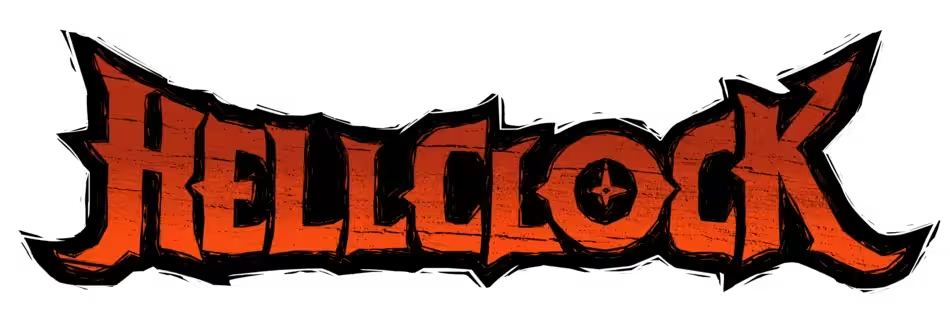Beginner's Guide
Welcome to the world of Hell Clock, a fast-paced rogue-lite action RPG that blends intense combat with deep progression systems. This guide will give you the essential knowledge to start your journey and conquer the demonic hordes!
What is Hell Clock?
Section titled “What is Hell Clock?”Hell Clock takes the best elements from games like Diablo III’s fluid combat, Grim Dawn’s intricate constellation trees, and Path of Exile’s expansive skill systems, then wraps them all in a high-octane rogue-lite package. The game is designed for speed and adaptability, pushing you to craft powerful builds on the fly and clear content quickly.
Core Gameplay Loop
Section titled “Core Gameplay Loop”Your adventure in Hell Clock revolves around two main modes: the Campaign and the challenging Endgame (Ascension Mode).
Campaign
Section titled “Campaign”Think of the campaign as an extended tutorial. It’s where you’ll learn the ropes, experiment with skills, and start building your power.
-
Acts and Floors: The campaign features three acts, each comprising 21 floors or rooms. To progress to the next act, you must clear all 21 floors in a single run.
-
Softcore vs. Hardcore:
-
Story: Dive into a narrative inspired by Brazilian history, infused with a classic heaven vs. hell conflict.
-
Pacing: The campaign is well-paced, taking around 15-20 hours for a casual playthrough without rushing.
Endgame Systems
Section titled “Endgame Systems”Once you’ve mastered the campaign, the Ascension Mode unlocks. This is where Hell Clock truly becomes a pure rogue-like, designed to test your build-crafting skills and adaptability to the extreme.
-
Reset and Retain: When you start an ascension, your gear and most skill tree progress reset. However, you keep your permanent currency (Soul Stones) and progress on completed “Promises,” which grant you Constellation Points.
-
Hell Levels: Each ascension lets you choose “Hell Levels,” which are negative modifiers that increase the game’s difficulty.
-
Limited Attempts: You begin with 7 “runs” per ascension. Successfully completing an act grants you 7 more runs.
-
Cursed Shrines: During your runs, you might encounter Cursed Shrines. These are incredibly tough wave-based encounters, but completing them rewards you with a valuable point for your Constellation Map!
Progression Systems
Section titled “Progression Systems”Hell Clock offers several interconnected systems to grow your character’s power.
Currency
Section titled “Currency”| Currency | Use | Persistent? |
|---|---|---|
| Soul Stones | Permanent currency used for Blessed Gear, Constellation Map and Infernal Bell upgrades | Yes |
| Gold | Temporary currency used only within a run for shops, rerolls, and statues | No |
Gear & Relics
Section titled “Gear & Relics”- Gear: Basic equipment pieces like weapons that define core stats such as damage and resistances.
- Blessed Gear: Permanent equipment that remains between runs. It is purchased from the NPC Jiao in the hub with Soul Stones.
- Relics: Crucial for amplifying abilities. Relics provide passive stat boosts instantly once slotted, even if you haven’t unlocked a related skill. You can upgrade them at the Reliquary by hovering over them and pressing Q.
- Trinkets: These are temporary, run-specific items that provide passive stat boosts (e.g., +17% Damage). They are wiped at the end of each run.
Skills & Skill Trees
Section titled “Skills & Skill Trees”- Skills: Unlock more active skills as you progress. Leveling increases power, but also cooldown and mana cost—balance is key.
- Blessings (Skill Leveling): A critical mechanic is that the game will only offer you Blessings (upgrades) for the skills you currently have equipped. Each skill has limited upgrade slots per run: 6 Common, 3 Magic, 2 Rare, and 1 Epic. This system encourages focusing on only 2-3 core skills to power them up much faster. You can see your current Blessings by pressing the “B” key.
- Skill Trees (Bells):
- The Great Bell: Skill tree used during the campaign for power growth.
- The Infernal Bell: Separate, extensive skill tree for endgame.
- Constellation Map: Massive passive tree unlocked after completing Act 3. Earn points by completing “promises” and clearing Cursed Shrines.
Tips for New Players
Section titled “Tips for New Players”-
Use the timer The game is designed around it. It forces fast decisions and better routing, which makes every run more exciting.
-
Stay flexible Don’t rely on specific drops. Adapt to what the game gives you and focus on relic or gear synergies.
-
Focus red enemies Red dots on the minimap are Elite enemies. They drop more XP, gold, and most importantly, Soul Stones. They’re worth chasing.
-
Spend your gold Gold doesn’t carry over. Use it for shop upgrades, rerolls, or to banish weak relic types.
Recommended Builds
Section titled “Recommended Builds”If you’re looking for solid starting points to power up your character, check out our carefully curated recommended builds. These provide reliable strategies for early and mid-game progression, focusing on strong synergies and effective playstyles.
Explore all detailed build guides on the Builds to find the perfect build for your style.
Additional Tips
Section titled “Additional Tips”- Invest in Red Portals (floor skips) and Meta Clock (extra time) nodes on your skill tree to speed up clear times.
- Potions drop frequently—use them liberally to maintain health. Upgrade your max potion count when possible.
- Expand relic inventory space early. The Great Bell node for this is a large icon with four squares in the middle.
- Focus on synergy between skills and relics, not just raw power.
- Prioritize defensive stats and skills in the early acts. Resistance nodes on the Great Bell grant 5% damage reduction per point.
- Don’t chase every Epic or Rare Blessing. Your high-rarity slots are limited. It’s often better to redraw options with Gold to find one that truly fits your build.
